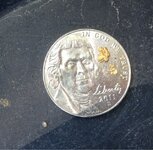G-bone
Sr. Member
- Dec 9, 2014
- 495
- 942
- Detector(s) used
- Gold Bug Pro w/ NEL coil.
Minelab Xterra 705,
Bazooka Snipers (24" and 30").
Royal Folding Sluice with Gold hog mats.
Thompson 12V Puffer Drywasher.
- Primary Interest:
- All Treasure Hunting
Yodels all...
So my question to every one is....
when you go out sampling a new area - how much color do you personally need to see from any given spot to make the decision to really work that area another day?
Went out again yesterday to the place I sampled last week.
I got about 5 specks from an area that looked promising so went back yesterday and gave that area some time.
Cleaned up the bedrock real good and moved approx. 8 unclassified buckets worth.
Actually ended up with less than my sample from the week before.
No skunk, but was kind of expecting more than than that.
Not complaining as it was an awesome day, but got me thinking about future testing.
Cheers
G
So my question to every one is....
when you go out sampling a new area - how much color do you personally need to see from any given spot to make the decision to really work that area another day?
Went out again yesterday to the place I sampled last week.
I got about 5 specks from an area that looked promising so went back yesterday and gave that area some time.
Cleaned up the bedrock real good and moved approx. 8 unclassified buckets worth.
Actually ended up with less than my sample from the week before.
No skunk, but was kind of expecting more than than that.
Not complaining as it was an awesome day, but got me thinking about future testing.
Cheers
G
Amazon Forum Fav 👍
Upvote
0










